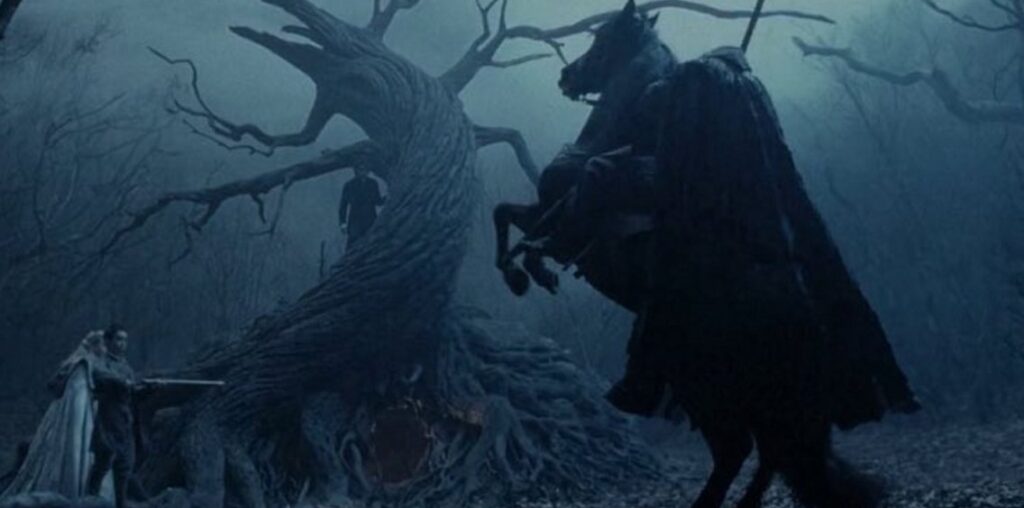
Irving, Headless Horseman and tourists
Published in 1820, “The Legend of Sleepy Hollow” claims the title of the first American short story, along with Irving’s other tale “Rip Van Winkle.” It has since been adapted into a Disney Cartoon and live action Tim Burton movie starring actor Johnny Depp.
The story observes the strange habits of an awkward village schoolteacher named Ichabod Crane. Crane seeks to win the hand of the rich and lovely Katrina Van Tassel, despite the advances of her more likely suitor, Brom Bones.
Along with the rest of the town, Crane enjoys ghost stories. One of these stories tells the tale of a Hessian soldier decapitated during the Revolutionary War who reenacts his fatal battle scene through the night — but returns to his grave in the churchyard before dawn. One fateful evening, Crane encounters the specter and mysteriously disappears.
The tale has attracted pilgrims of varied intentions to its haunted churchyard. But the complicated relationship with the Headless Horseman and his many fans extends to more than the church.
Tourism has been a massive boost to the village’s economy. Lucia Ballas-Traynor, Executive Director of the Sleepy Hollow Tarrytown Chamber of Commerce, said the annual Halloween Parade — a Sleepy Hollow staple — typically attracts 7,000 attendees. After 2022, she said, attendance was closer to 14,000.
This surplus of visitors has real financial benefits, she said, anf that “you hear of stories of a convenience shop that made in one day — when there was an event going on—what they would have made in an entire month.”
“However,” she added, “then you have those businesses that provide services — like the beauty salons — their customers stay away because they’re local.”
It’s also been a logistical issue in terms of parking and traffic. Large tour buses come in for the festival and are unable to fit anywhere. This makes Ballas-Traynor’s job, a little different during the fall.
“Tourism is not supposed to be my role. … The role of the chamber is advocating for and promoting local businesses,” she said.
While these tourists aren’t all trying to plan spooky weddings or attend Sunday morning services, the Old Dutch Church is still not safe from the swarms of Halloween visitors. The graveyard gets the brunt of abuse. Many travel to the site to witness Irving’s very own moss-stained grave that’s located there. Despite having no official affiliation with the cemetery, the church stands surrounded by its gravestones.
According to Ballas-Traynor, the problems include “young people drinking and loitering,” a car that once drove over a tombstone and, naturally, “influencers trying to do a photo shoot.”
Dr. Sara Mascia, Executive Director of The Historical Society of Sleepy Hollow and Tarrytown, said the church was built after a sizable population of Dutch immigrants settled in the area.
It was likely built in 1697, Mascia said, and that “[Irving] came here as a teen, in the late 1790s. So, when the church was probably about 100 years old.”
Mascia said that “it’s been an operating church since it opened.” That means that now the church has been active for 300 years. However, due to the lack of lighting and heating of the colonial structure, a second building was built in 1837 to better accommodate the congregants. But, ever faithful to their history, the church continues to meet in the original building during the warmer months.
The way Mascia tells it, the Sleepy Hollow story must have largely come together during Irving’s stay in Tarrytown.
“He attended church here, he went through the churchyard, he saw the names on the headstones, he heard the stories about the people that lived here during the American Revolution.”
One of the graves Irving likely observed was that of Catriena Van Tessel, which almost certainly inspired the name Katrina Van Tassel.
Irving, a Scottish Presbyterian who grew up in a religious home, was heavily influenced by exploring and experiencing the town. But his own influence on the town was so great, that he might have named the place. Sleepy Hollow was named North Tarrytown from 1874-1996. Before that, it was just part of Mount Pleasant.
Mascia said that some early maps identified a small cove at the bottom of the Hudson River as Sleepy Hole, Sleepy Cove or, as it would come to be known, Sleepy Hollow. In other words, Irving likely did not invent the label, but the impact of his story is what gave the residents the push to officially adopt the name.
“If there was no Old Dutch Church of Sleepy Hollow,” Gargano said, “there would not even be a village called Sleepy Hollow.”

